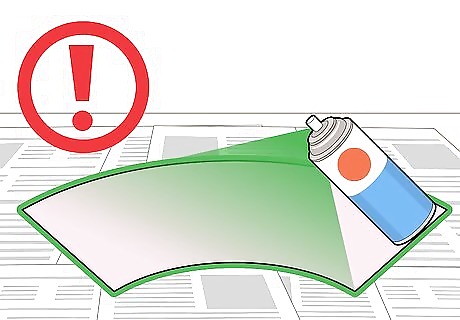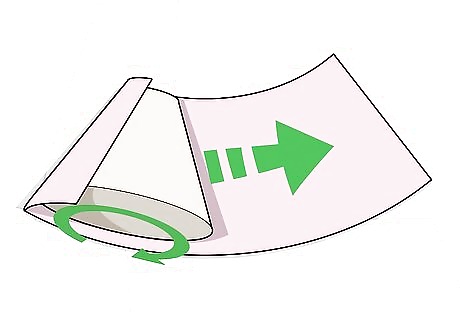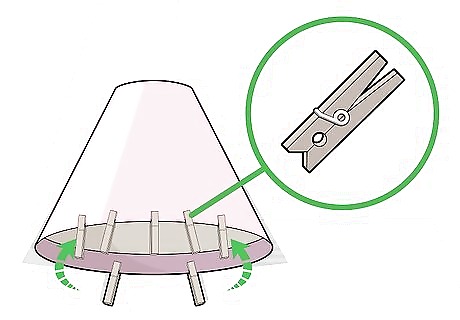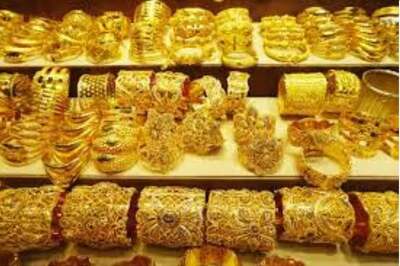
views
Removing Old Fabric

Clear off a big enough work space to fit your materials. You will want to work at a table, as you will need a flat surface where you can spread out all of your materials. You should consider putting newspaper down on the table and on the ground surrounding your work station because spray adhesive can stick to almost any surface and could do damage to your furniture or floor.

Remove any old fabric from the lampshade frame. If the old fabric of your shade is torn or ruined in any way, you'll want to remove it before you recover the shade. Remove the trim (if there is any) by pulling on it; it should come off easily. Using scissors, puncture the old fabric and gently cut sections away from the frame. Make sure you don't cut the liner fabric. You should also remove the old fabric if it's a darker color than the fabric you're using to recover the lampshade. If the original fabric is thick, keep in mind that light might have a hard time getting through 2 layers of fabric. If you're covering a plastic lampshade liner, you don't need to remove anything.

Take off any decorations or ribbons if you're keeping the old fabric. If the old fabric is intact, you don't have to completely remove it. Instead, just remove decorations or ribbons. You can use a pair of small scissors or a sewing blade to cut through ribbon without puncturing the shade. Then, pull it away.

Choose a thin, lightweight fabric. When recovering a lamp, you will want to choose a fabric that is lightweight and relatively thin. If the fabric is too heavy, the light from the lamp won't be able to shine through. When you're choosing your fabric, stick to thin fabric like cotton. You can also test the fabric by holding it up to a light and making sure enough comes through. Another thing to keep in mind is the pattern of your fabric. Drum and rectangular lampshades will look great in any fabric. Tapered lampshades look best in more randomized patterns.
Creating a Template

Use tracing paper and a pencil to trace the shape and size of your shade. Lay your shade on its side on the tracing paper. Make a mark on your shade so you know where you began. Then roll your lamp shade along the paper, tracing the path it makes with a pencil. Make sure you're marking along the top and bottom of the shade.

Use a yardstick or ruler to connect the 2 edges of your tracing. If you have a drum or rectangular shade, the top and bottom edges of the tracing should be exactly parallel. Use a yardstick or ruler to draw a line connecting the edges. If you have a tapering pendant shade, the top line will be shorter than the bottom line. Use a yardstick or ruler to connect the edges at an angle. The exact angle you need to draw for a tapered shade will vary depending on the size of the shade and the angle of the taper. As long as the ends of the top left and bottom left lines are connected, and the top right and bottom right lines are connected, the angle will be fine.

Add about 1 in (2.5 cm) around the edge of your markings. You will want a bit of extra fabric to work with. Adding an extra 1 in (2.5 cm) to each edge of your tracing will give you enough extra fabric.

Cut out your pattern. Once you've added the extra length to your pattern, use scissors to cut it out. You will use this pattern to trace the shape and size of your shade onto your chosen fabric.
Cutting the Fabric

Spread the fabric face down on your work surface. Make sure there is no bunching or wrinkling and that the material is completely smooth on the flat surface. You want it to be smooth so that you do not accidentally cut across a wrinkle and end up with an uneven fabric cover for your lamp. If the fabric is wrinkled, iron it before you lay it out. If the fabric is old or you've repurposed it from another project, consider washing it first.

Trace your template onto your fabric. Lay your template down on top of your fabric. Then use a pencil, chalk, or disappearing ink marker to trace the outline of the template onto your fabric. If you're worried about the template staying in place, you can use straight pins to secure the template to the fabric. Pin the template at the corners.

Use fabric scissors to cut the template out of your fabric. Fabric scissors will cut through the fabric better than regular scissors will, preventing frayed edges. Gently cut the material along the lines you traced from the template. Remove any remaining fabric from the work surface.
Recovering the Shade

Spray the underside of the fabric with adhesive. Lay the fabric out flat, face down. Apply a spray adhesive to the fabric, holding the can about 3 in (7.6 cm) away from the fabric. It is very important that you do this in a well-ventilated area, as spray adhesive can make you very ill if you breathe in too much of it.

Avoid spraying the adhesive on anything besides the fabric. Remember that spray adhesive is incredibly sticky (and permanent). If you accidentally spray it on anything else, you could have a mess on your hands! Cover the floor around your work area with newspaper and cover any furniture with a sheet or blanket.

Position your lamp about 1 in (2.5 cm) from the edges of the fabric. Carefully set your shade down on the fabric, about 1 in (2.5 cm) from the edge, top, and bottom. If you're recovering a tapered shade, make sure you match the top of the shade to top of the fabric and the bottom of the shade to the bottom of the fabric. You don't want to put the fabric on upside down! The edges of the shade should be parallel to the edges of the fabric, too, no matter the shape of your shade.

Roll your shade onto the fabric. Move slowly, holding the fabric taut at the other end as you go. Make sure that the fabric is always flat. Otherwise, you'll get wrinkles in the fabric.

Fold over extra fabric at the end to create a seam. Once you've rolled your shade all the way down the fabric, you'll have a bit of extra fabric along the vertical edge. Fold the extra fabric under so the edge is hidden and you have a straight seam. Use a hot glue gun to adhere the seam to the lamp shade.

Fold over the edges and secure them with clothespins. Once your fabric is attached to the shade, fold over the edges at the top and bottom and then secure them with clothespins. This will keep the fabric secure and will also encourage the adhesive to adhere. If you haven't sprayed the adhesive to the edges of the fabric, that's okay. Instead, use a hot glue gun to secure the edges to the inside of the lampshade.

Add a border or decorations to finalize your design. To really make your lampshade look store bought, add a border around the bottom edge of the lamp. Simply use a hot glue gun to stick a thicker piece of fabric along the top and bottom edges of your lamp. You can also add fringe, rickrack or other types of materials to cover the hems on the top and the bottom of the newly covered lampshade. Try to match the seam of the border to the seam of the fabric for an even look.



















Comments
0 comment